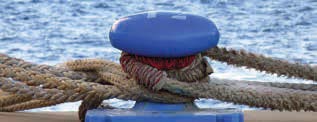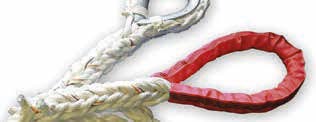
During use, ropes should be regularly inspected over
the entire length and it is recommended to keep a record
of the inspection results.
However, visual inspection
can only give an indication of the condition of the rope.
Residual rope strength can only be measured through
breaking tests. Some discard/repair criteria are given in
the table below.
| Damage | Repair / resplice (if local) | Discard |
|---|---|---|
| ALL ROPES | ||
| More than 25% of the fiber broken | X | X |
| Shock load – overload: inconsistent diameter/texture/stiffness |
X | X |
| Exposure to extreme temperature | X | |
| Glazed areas | X | X |
| Heavily powdered / abraded internal strand areas | X | |
| Progressive heavy surface abrasion | X | X |
| UV damage: discolored, splintered and powdered surface | X | |
| Chemical exposure: discolored rope sections other than usual soiling | X | X |
| Terminations: check splices and tucks for movement or misalignment, abrasion or damage of the eye crown and eye protections | X | |
| BRAIDED COVER AND CORE ROPES | ||
| De kern is zichtbaar doorheen de mantel maar niet beschadigd. Herstel de mantel. | X | X |
| Beschadiging van de kern: gebroken of zwaar geschavielde garens of strengen | X | X |
| Verschillende uitstulpingen over de volledige touwlengte | X | |


This table gives an indication of the resistance of ropes to chemical exposure.
| ROPE TYPE | Polyester | Polyamide | Polypropylene | HMPE | Steel wire |
|---|---|---|---|---|---|
| Acids | XXX | X | XXX | XXX | X |
| Alkalis | X | XXX | XXX | XXX | X |
| Solvents | XXX | XXX | XXX | XXX | XXX |